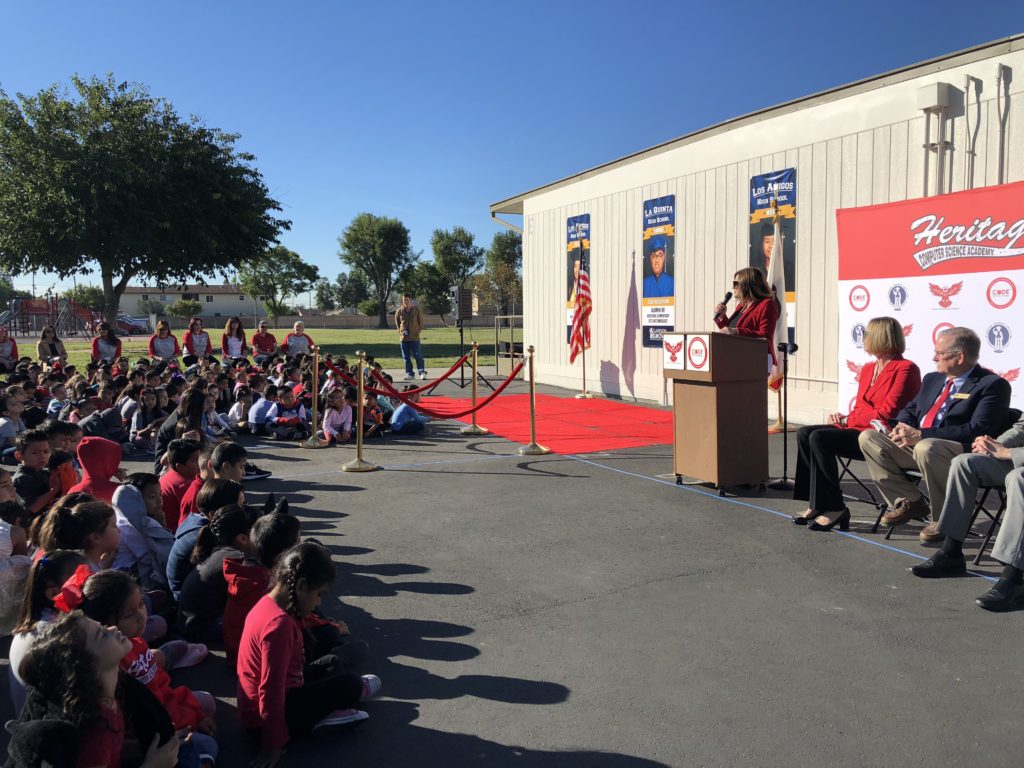The younger kids might not fully grasp what coding and robotics will mean for their future job prospects. But they were plenty excited to showcase some of the cool projects they’re working on in class.
Donning their school colors of red and black, hundreds of students gathered Thursday morning with parents, staff and community members to celebrate the opening of the Garden Grove Unified School District’s first-ever computer science academy.
Thanks to a partnership with the organization Code to the Future, Heritage Elementary School is now the Heritage Elementary Computer Science Immersion Academy, integrating coding, robotics and other high-tech skills into everyday instruction.
 The K-6 campus in Santa Ana officially kicked off the program in August, when students returned from summer break. Less than two months later, Thursday’s Launch Party was akin to a dedication ceremony, featuring a symbolic ribbon-cutting and remarks by local dignitaries out on the blacktop, followed by in-class demonstrations.
The K-6 campus in Santa Ana officially kicked off the program in August, when students returned from summer break. Less than two months later, Thursday’s Launch Party was akin to a dedication ceremony, featuring a symbolic ribbon-cutting and remarks by local dignitaries out on the blacktop, followed by in-class demonstrations.
“We’ve only been in school less than 50 days,” Principal Michelle Pinchot told students. “In such a short time, the transformation has been unbelievable. When we walk into classrooms, we can’t believe the enthusiasm and excitement and how engaged you are with the projects you’re doing. Not only with coding, but how you’re integrating technology all day long.”
Garden Grove Unified’s Board of Education first took note of Code to the Future and its role in establishing computer science magnet schools nearly two years ago at a conference in San Francisco. President Bob Harden said he knew right away it was a relationship worth exploring. The board approved the partnership in February, giving the green light for Code to the Future to provide training, coaching, lesson guides and an overall framework for infusing technology across all content areas.
Addressing students and their parents, Harden held up his smartphone to illustrate the technological advances that have occurred in his own lifetime, including the exponential growth of digitization. The future, he said, will be increasingly driven by code.
“Many of the opportunities for success in that world will depend on your ability to manipulate code,” he said. “That’s what we’re teaching your children here. We’re teaching them the language of the future, the language of code.”
Code to the Future CEO Andrew Svehaug said his organization is working to “inspire students to realize their incredible potential and to equip them with the skills necessary for success in school and in life.”
Workforce statistics, Svehaug said, indicate there are already more than one million computer science jobs that have not been filled due to a shortage of qualified workers. That gap is expected to widen.
“One of the facets of what we’re doing here with computer science immersion is to set students up with the skills necessary, that if they wanted to be prepared for a job in computer science — whether in the IT sector or in another industry that uses computer science — they would have those skills,” he said. “But even more important, we believe that teaching students the language of technology will prepare them for whatever path they take. This is an opportunity to make school even more engaging and exciting by bringing computer science into the classroom.”
Svehaug said his program engages students with three different cycles throughout the year. The first connects students to coding fundamentals, using a drag-and-drop interface. The second is based on robotics, utilizing Legos and other hands-on activities. The third cycle is based on the popular building game Minecraft, but it will also introduce the upper grades to text-based coding, he said.
Officials believe that by grade six, Heritage students will have mastered the kinds of high-level technology skills currently taught in high school — and they’ll be prepared to take the high school Advanced Placement Computer Science exam.
Thursday’s ceremony included several elected officials, including GGUSD board members, Congressman Lou Correa and Orange County Supervisor Andrew Do. Afterward, many of the guests visited classrooms to see students using basic coding principles to develop their own video games and adventure stories.
Administrators also showed off the school’s new Innovation Lab, which features green-screen technology, a 3D printer, maker-space STEM tools, and collaboration space for coding and robotics.
Why computer science, and coding specifically? Heritage sixth-grade Andrea Valdovinos didn’t equivocate.
“Because our future depends on it,” she said. “When the average employee at Google was my age, Google wasn’t even invented. Now, it’s a part of our everyday lives. We are being prepared for not only jobs that are out there, but jobs that haven’t been created or imagined.”
